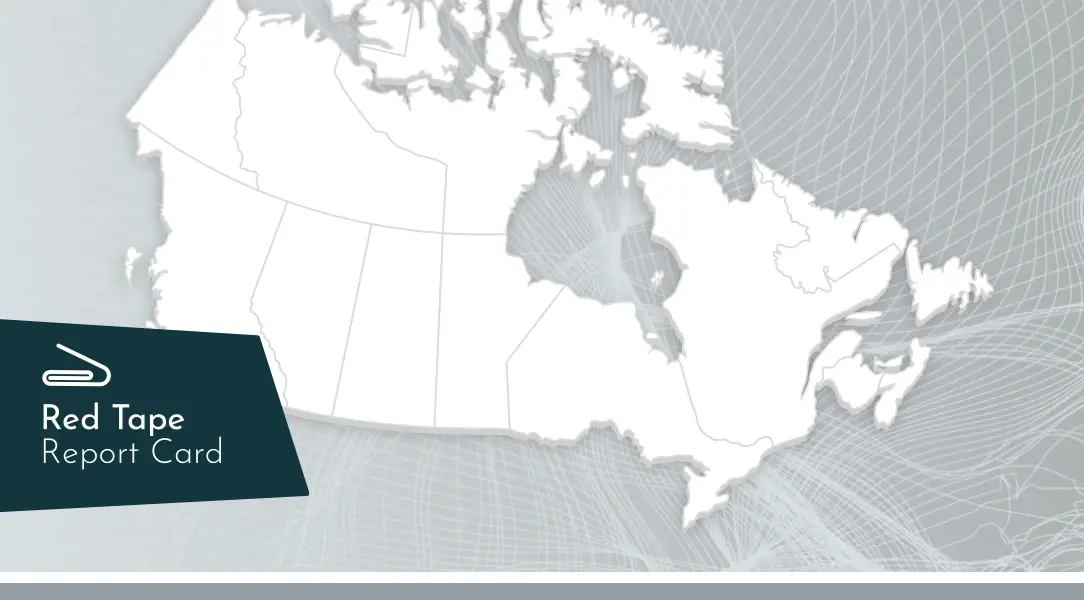
The Canadian Federation of Independent Business’s (CFIB) 2025 Red Tape Report Card grades three major areas of regulatory performance: regulatory accountability, regulatory burden, and political priority. Within this framework, governments with the highest overall scores are those that have a comprehensive measure of their regulatory burden, maintain some form or regulatory budget, are making efforts to minimize red tape, and which display evidence that red tape reduction and regulatory modernization are a government priority that is championed by the Premier/Prime Minister and cabinet. For details on how scores were calculated, and the changes applied to the methodology since the 2024 edition of the Report Card, refer to the Methodology section in Appendix F.
Grades are highest for the accountability section of the report card. Most provinces now have some form of measurement, reporting, budgeting, and make regulatory documents accessible to the public (in some form), generating several “A” grades where there were none when we first published our report card over a decade ago. This section of the report card represents 40% of the overall grade.
Regulatory burden remains a more challenging area of regulatory performance to measure as data related to regulatory burden that can be used to compare jurisdictions is very limited. Overall, grades in the burden section are relatively lower than that of the accountability section, with only one province achieving an “A” grade. The burden section represents 40% of the overall grade.
Only a few jurisdictions achieve an “A” grade grade in the political priority section, indicating much work remains to be done to show that red tape reduction and regulatory modernization are clear priorities for governments. Political priority represents 20% of the overall grade.
This year we have introduced a bonus indicator based on the previous year’s Red Tape Awareness Week Red Tape Challenge - we are awarding governments for their efforts in accepting our 2024 call to undertake two red tape reduction initiatives for housing. Six provinces receive full bonus points, worth an additional 2% added to the overall grade. Scores awarded in the bonus indicator serve exclusively to improve the overall grade and do not adversely affect scores where governments were either partially engaged, or did not accept, the challenge.
- Score: 10 is best, 0 is worst. Using a weighting scheme, the four subindex scores are combined into a single score that allows for a ranking of governments from best (highest score) to worst (lowest score). The different areas are assigned the following weights: regulatory accountability ─ 40%, regulatory burden ─ 40%, political priority ─ 20%, and (bonus) housing initiatives ─ 2%.
- Grade: A, A-: 8.7-10 (Excellent performance); B+, B, B-: 7.5-8.6 (Good performance); C+, C, C-: 6.0-7.4 (Satisfactory performance); D: 5-5.9 (Less than satisfactory performance); F: 0-4.9 (Unsatisfactory performance).
- Due to a change in government in New Brunswick in October 2024, CFIB has assigned the province a status of “NA” (Not applicable) in lieu of a grade in the political priority section. As a result, the province is also marked as “NA” for the overall grade in this year’s report card, acknowledging the transition to a new government. We will resume grading New Brunswick in all categories in our 2026 report card.
Related Documents
| Release Date | Report | Download |
|---|---|---|
| January 2025 | Provincial Red Tape Report Card, 15th Edition |
PDF (4.2 MB) |
| February 2024 | Provincial Red Tape Report Card, 14th Edition |
PDF (2.6 MB) |
| February 2023 | Provincial Red Tape Report Card, 13th Edition |
PDF (1.12 MB) |
| February 2022 | Provincial Red Tape Report Card, 12th Edition |
PDF (1.02 MB) |
| January 2021 | Provincial Red Tape Report Card, 11th Edition |
PDF (890 KB) |

 Share Article
Share Article
 Print Article
Print Article

